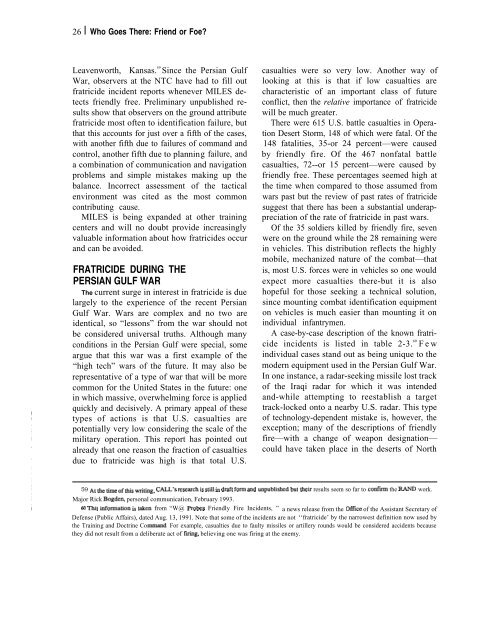Who Goes There: Friend or Foe? - Federation of American Scientists
Who Goes There: Friend or Foe? - Federation of American Scientists
Who Goes There: Friend or Foe? - Federation of American Scientists
Create successful ePaper yourself
Turn your PDF publications into a flip-book with our unique Google optimized e-Paper software.
26 I <strong>Who</strong> <strong>Goes</strong> <strong>There</strong>: <strong>Friend</strong> <strong>or</strong> <strong>Foe</strong>?<br />
Leavenw<strong>or</strong>th, Kansas. 59<br />
Since the Persian Gulf<br />
War, observers at the NTC have had to fill out<br />
fratricide incident rep<strong>or</strong>ts whenever MILES detects<br />
friendly free. Preliminary unpublished results<br />
show that observers on the ground attribute<br />
fratricide most <strong>of</strong>ten to identification failure, but<br />
that this accounts f<strong>or</strong> just over a fifth <strong>of</strong> the cases,<br />
with another fifth due to failures <strong>of</strong> command and<br />
control, another fifth due to planning failure, and<br />
a combination <strong>of</strong> communication and navigation<br />
problems and simple mistakes making up the<br />
balance. Inc<strong>or</strong>rect assessment <strong>of</strong> the tactical<br />
environment was cited as the most common<br />
contributing cause.<br />
MILES is being expanded at other training<br />
centers and will no doubt provide increasingly<br />
valuable inf<strong>or</strong>mation about how fratricides occur<br />
and can be avoided.<br />
FRATRICIDE DURING THE<br />
PERSIAN GULF WAR<br />
The current surge in interest in fratricide is due<br />
largely to the experience <strong>of</strong> the recent Persian<br />
Gulf War. Wars are complex and no two are<br />
identical, so “lessons” from the war should not<br />
be considered universal truths. Although many<br />
conditions in the Persian Gulf were special, some<br />
argue that this war was a first example <strong>of</strong> the<br />
“high tech” wars <strong>of</strong> the future. It may also be<br />
representative <strong>of</strong> a type <strong>of</strong> war that will be m<strong>or</strong>e<br />
common f<strong>or</strong> the United States in the future: one<br />
in which massive, overwhelming f<strong>or</strong>ce is applied<br />
quickly and decisively. A primary appeal <strong>of</strong> these<br />
types <strong>of</strong> actions is that U.S. casualties are<br />
potentially very low considering the scale <strong>of</strong> the<br />
military operation. This rep<strong>or</strong>t has pointed out<br />
already that one reason the fraction <strong>of</strong> casualties<br />
due to fratricide was high is that total U.S.<br />
casualties were so very low. Another way <strong>of</strong><br />
looking at this is that if low casualties are<br />
characteristic <strong>of</strong> an imp<strong>or</strong>tant class <strong>of</strong> future<br />
conflict, then the relative imp<strong>or</strong>tance <strong>of</strong> fratricide<br />
will be much greater.<br />
<strong>There</strong> were 615 U.S. battle casualties in Operation<br />
Desert St<strong>or</strong>m, 148 <strong>of</strong> which were fatal. Of the<br />
148 fatalities, 35-<strong>or</strong> 24 percent—were caused<br />
by friendly fire. Of the 467 nonfatal battle<br />
casualties, 72--<strong>or</strong> 15 percent—were caused by<br />
friendly free. These percentages seemed high at<br />
the time when compared to those assumed from<br />
wars past but the review <strong>of</strong> past rates <strong>of</strong> fratricide<br />
suggest that there has been a substantial underappreciation<br />
<strong>of</strong> the rate <strong>of</strong> fratricide in past wars.<br />
Of the 35 soldiers killed by friendly fire, seven<br />
were on the ground while the 28 remaining were<br />
in vehicles. This distribution reflects the highly<br />
mobile, mechanized nature <strong>of</strong> the combat—that<br />
is, most U.S. f<strong>or</strong>ces were in vehicles so one would<br />
expect m<strong>or</strong>e casualties there-but it is also<br />
hopeful f<strong>or</strong> those seeking a technical solution,<br />
since mounting combat identification equipment<br />
on vehicles is much easier than mounting it on<br />
individual infantrymen.<br />
A case-by-case description <strong>of</strong> the known fratricide<br />
incidents is listed in table 2-3. 60<br />
Few<br />
individual cases stand out as being unique to the<br />
modern equipment used in the Persian Gulf War.<br />
In one instance, a radar-seeking missile lost track<br />
<strong>of</strong> the Iraqi radar f<strong>or</strong> which it was intended<br />
and-while attempting to reestablish a target<br />
track-locked onto a nearby U.S. radar. This type<br />
<strong>of</strong> technology-dependent mistake is, however, the<br />
exception; many <strong>of</strong> the descriptions <strong>of</strong> friendly<br />
fire—with a change <strong>of</strong> weapon designation—<br />
could have taken place in the deserts <strong>of</strong> N<strong>or</strong>th<br />
59 At he tie <strong>of</strong> ~~ ~~g, c~’s mse~ch iss~ ~ tit f<strong>or</strong>m ~d ~published but their results seem so far to confkn the ~ w<strong>or</strong>k.<br />
Maj<strong>or</strong> Rick Bogdeu personal communication, February 1993.<br />
@ ~s ~omation is ~en from “W@ Robes <strong>Friend</strong>ly Fire Incidents, ” a news release from the Offke <strong>of</strong> the Assistant Secretary <strong>of</strong><br />
Defense (Public Affairs), dated Aug. 13, 1991. Note that some <strong>of</strong> the incidents are not ‘‘fratricide’ by the narrowest definition now used by<br />
the Training and Doctrine C<strong>or</strong>nmand. F<strong>or</strong> example, casualties due to faulty missiles <strong>or</strong> artillery rounds would be considered accidents because<br />
they did not result from a deliberate act <strong>of</strong> ftig, believing one was firing at the enemy.
















